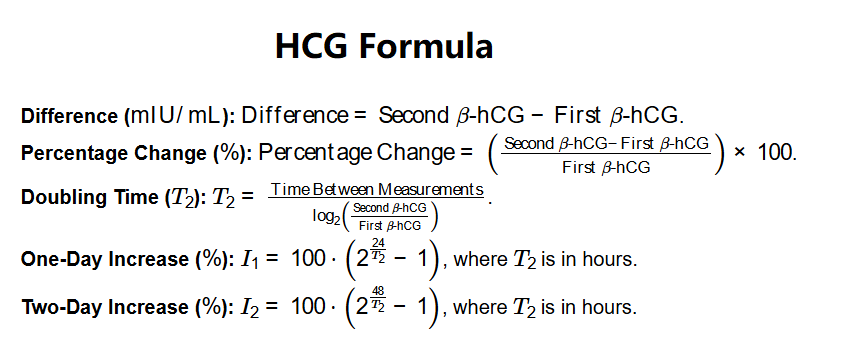1. What is an hCG Levels Calculator?
Definition: This calculator computes the progression of β-hCG levels in early pregnancy, including the difference, percentage change, doubling time, one-day increase, and two-day increase, given two β-hCG measurements and the time between them. β-hCG (human chorionic gonadotropin) is a hormone produced by the placenta during pregnancy.
Purpose: It assists in monitoring early pregnancy progression, often used after IVF or in high-risk pregnancies to assess viability and detect potential complications like miscarriage or ectopic pregnancy.
2. How Does the Calculator Work?
The calculator uses the following formulas:
- Difference (\( \text{mIU/mL} \)): \( \text{Difference} = \text{Second } \beta\text{-hCG} - \text{First } \beta\text{-hCG} \).
- Percentage Change (\( \% \)): \( \text{Percentage Change} = \left(\frac{\text{Second } \beta\text{-hCG} - \text{First } \beta\text{-hCG}}{\text{First } \beta\text{-hCG}}\right) \times 100 \).
- Doubling Time (\( T_2 \)): \( T_2 = \frac{\text{Time Between Measurements}}{\log_2\left(\frac{\text{Second } \beta\text{-hCG}}{\text{First } \beta\text{-hCG}}\right)} \).
- One-Day Increase (\( \% \)): \( I_1 = 100 \cdot \left(2^{\frac{24}{T_2}} - 1\right) \), where \( T_2 \) is in hours.
- Two-Day Increase (\( \% \)): \( I_2 = 100 \cdot \left(2^{\frac{48}{T_2}} - 1\right) \), where \( T_2 \) is in hours.
Unit Conversions:
- Time Units: hours, days (1 day = 24 hours).
Steps:
- Input the first and second β-hCG levels (in mIU/mL) and the time between measurements (in hours or days).
- Validate inputs (hCG levels and time must be positive; second hCG must be greater than the first).
- Convert the time between measurements to hours for calculations.
- Compute the difference, percentage change, doubling time, one-day increase, and two-day increase using the formulas above.
- Convert the doubling time to the selected output unit (hours or days).
- Format outputs to 4 decimal places or scientific notation for small values.
3. Importance of hCG Levels Calculations
Calculating hCG levels progression is crucial for:
- Pregnancy Monitoring: Ensures the pregnancy is developing normally by tracking hCG doubling rates.
- Risk Assessment: Identifies potential issues like miscarriage or ectopic pregnancy if hCG levels rise too slowly.
- IVF Follow-Up: Monitors early pregnancy after embryo transfer to confirm implantation and progression.
4. Using the Calculator
Examples:
- Example 1: First β-hCG: 100 mIU/mL, Second β-hCG: 200 mIU/mL, Time: 2 days
- Convert Time: \( 2 \, \text{days} = 48 \, \text{hours} \).
- Difference: \( 200 - 100 = 100.0000 \, \text{mIU/mL} \).
- Percentage Change: \( \left(\frac{200 - 100}{100}\right) \times 100 = 100.0000 \, \% \).
- Doubling Time: \( 48 / \log_2\left(\frac{200}{100}\right) = 48.0000 \, \text{hours} = 2.0000 \, \text{days} \).
- One-Day Increase: \( 100 \cdot \left(2^{\frac{24}{48}} - 1\right) = 41.4214 \, \% \).
- Two-Day Increase: \( 100 \cdot \left(2^{\frac{48}{48}} - 1\right) = 100.0000 \, \% \).
- Example 2: First β-hCG: 150 mIU/mL, Second β-hCG: 240 mIU/mL, Time: 72 hours
- Difference: \( 240 - 150 = 90.0000 \, \text{mIU/mL} \).
- Percentage Change: \( \left(\frac{240 - 150}{150}\right) \times 100 = 60.0000 \, \% \).
- Doubling Time: \( 72 / \log_2\left(\frac{240}{150}\right) \approx 90.2137 \, \text{hours} \approx 3.7589 \, \text{days} \).
- One-Day Increase: \( 100 \cdot \left(2^{\frac{24}{90.2137}} - 1\right) \approx 19.4727 \, \% \).
- Two-Day Increase: \( 100 \cdot \left(2^{\frac{48}{90.2137}} - 1\right) \approx 42.7365 \, \% \).
5. Frequently Asked Questions (FAQ)
Q: What is β-hCG?
A: β-hCG (human chorionic gonadotropin) is a hormone produced by the placenta during pregnancy, detectable in blood and urine to confirm and monitor pregnancy.
Q: Why is the doubling time important?
A: Doubling time indicates how quickly hCG levels are rising, which is a key indicator of a healthy early pregnancy. Normal doubling time is typically 48–72 hours in early pregnancy.
Q: What does a slow rise in hCG levels mean?
A: A slow rise may indicate potential issues like miscarriage or ectopic pregnancy, but it’s not definitive. Consult your healthcare provider for further evaluation.
 Home
Home
 Back
Back
